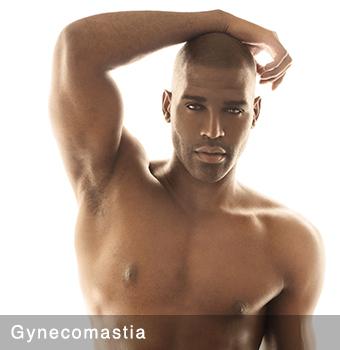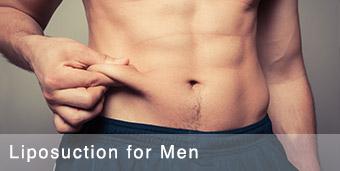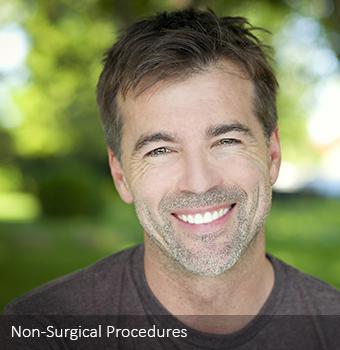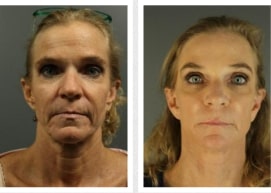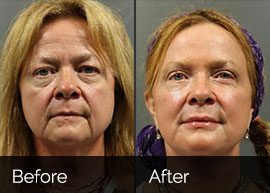Gynecomastia
Want To See Real Gynecomastia Results?
Before & After Gallery
Be sure to view our gynecomastia gallery to see real patient results.
Click Here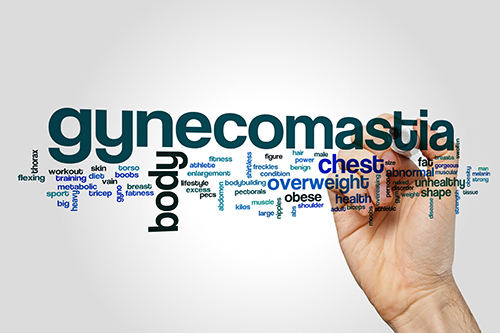
If you have gynecomastia, you can’t take off your shirt at the gym or on the beach without feeling self-conscious. Even though the condition is embarrassing, enlarged breast tissue in men is very common. Luckily, it can be corrected with gynecomastia surgery, also called male breast reduction. Chest contouring is a focus of Dr. Reid’s practice. As it is a specialty of his, Dr. Reid has operated on a large number of these patients and has created a “center of excellence” for chest contouring at Restora Austin and Inspire Surgery Centre. Due to his experience, many patients travel from all over the world to the have their chest contouring treatment with him. His goal is for you to be educated about this condition so that together, you can have an individualized treatment plan to attain your aesthetic goals.
What is Gynecomastia?
Gynecomastia comes from the Greek meaning “feminine breast” and means enlargement of the breast tissue in men. It affects roughly 40% of men in the U.S. and can affect both breasts or only one.
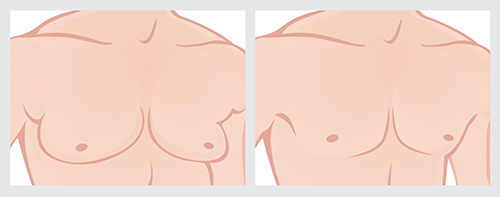
What are the social/emotional effects of Gynecomastia?
Although not life threatening, men that are affected by gynecomastia often suffer from embarrassment or humiliation because of the condition. It can lead to depression in any of the age groups affected by the condition. Many men with gynecomastia may avoid removing their shirts, avoid swimming, or even avoid intimacy due to the shame associated with their appearance. It is difficult for others to understand how deeply this condition can affect a man, and men frequently don’t share their concerns with their family or loved ones. A recent article from the definitive journal for plastic surgery, Plastic & Reconstructive Surgery found that, “Merely having gynecomastia was sufficient to cause significant deficits in general health, social functions, mental health, self-esteem, and eating behaviors and abilities compared with controls.” This means that the condition has a HUGE impact on those who suffer from it! This is the reason that Dr. Reid has made the treatment of gynecomastia one of the focuses of his practice, and how he has become one of the leaders in plastic surgery for chest contouring of all types.

What are the signs of gynecomastia vs. the Ideal Male Chest?
In order to fully understand the problems that occur with the male chest, it’s important to review the “ideal” male chest. In the ideal male chest, the underlying pectoralis muscle is highlighted. This results in more fullness in the top of the male breast with a more broad or horizontal orientation of the breast tissue. There is a defined and horizontal line at the bottom of the pectoralis muscle. As more breast tissue occurs in the lower aspect of the male breast, it takes on a more round or feminine appearance. The nipple and areola are also quite flat in a man, and dense tissue behind the areola can give the appearance of a “puffy” nipple which is also feminizing. It is important to note, that the ideal male breast does contain a small layer of fat and breast tissue, and therefore a small amount of tissue must be left in place to give the result when treating gynecomastia. Of course, not everyone can have the “ideal” chest, and weight, age, and body type must be considered for each person.

When does gynecomastia most often occur in men?
It is normal for males in puberty to have some swelling and tenderness of the breasts and nipple area in response to the hormonal changes of the body during this time. This should be for a limited time, and prolonged enlargement of the breast tissue is not normal. Breast tissue in a young man that lasts for more than a year or past the age of 18 should be evaluated. Fully developed men can also be affected by gynecomastia. This can be from several causes as discussed below. It can be from natural changes in hormone balance. And can often occur for unknown reasons. Men older than 50 may notice gynecomastia as the ratio of testosterone to estrogen changes in them, a condition often known as “andropause”. Depending on the age of the patient and the cause of the gynecomastia, the swollen breasts may be made up more of glandular breast tissue or more of fatty tissue. The consistency of the tissue can affect treatment options, as discussed below.
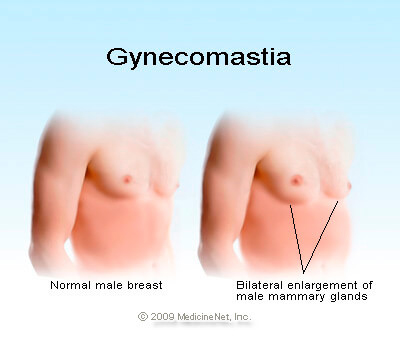
What is Adolescent Gynecomastia?
Adolescent gynecomastia is caused by an imbalance between testosterone and estrogen as a male goes through puberty. Testosterone is responsible for masculine traits such as body hair growth and an increase in muscle mass. Estrogen, although always present in males, when increased can cause feminine characteristics to develop such as breast growth. During the temporary disproportion of estrogen to testosterone that occurs in some males during puberty, this may lead to growth of the breast tissue. This frequently causes only tenderness and a small increase in size or just “puffy” nipples and areolas. This condition typically resolves on its own. However, in about 10% of cases, the tissue persists and can become harder or more fibrous. If the condition lasts longer than a year and/or is emotionally troubling to the young man, professional intervention is appropriate. These young men respond very well to surgical treatment, because the effects are immediate and long-term, due to the elastic and pliable nature of their young skin. Although surgery is usually reserved until after the age of 18, sometimes, depending on the severity of the condition and the emotional response of the patient, earlier intervention may be required.
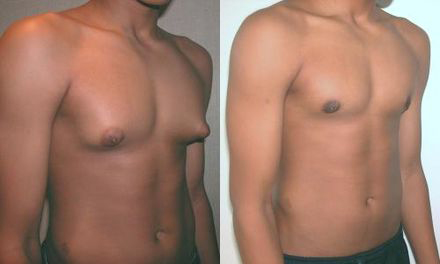
What causes gynecomastia in adult males?
Although a large number of cases of gynecomastia occur with no defined cause, there are some known triggers for the condition. Any condition that leads to a disproportion of estrogen to testosterone in a man can prompt the condition. Other causes include:
Medications
-Antiandrogens (often used for enlarged prostate)
-Anabolic steroids
-Anxiety medications
-Antidepressants
-Some antibiotics
-Chemotherapy
-Some heart medications
-HIV medications (HAART)
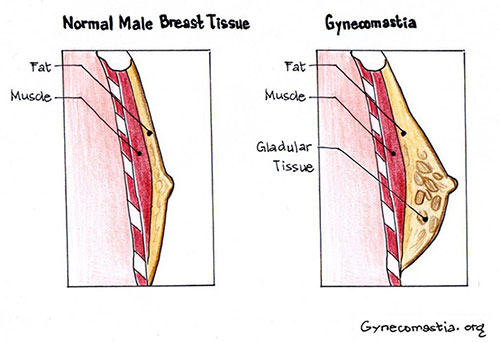
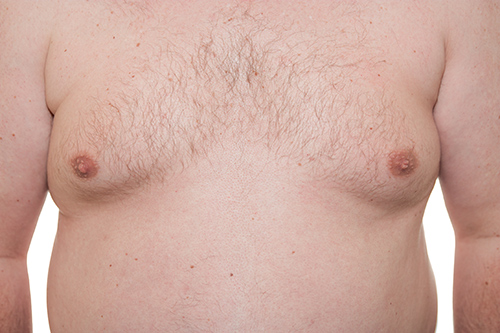
How is Gynecomastia Diagnosed?
The diagnosis of gynecomastia is made by a thorough examination including an in-depth physical, medical, and family history. Laboratory tests or radiologic studies may be required based on this information. Dr. Reid will sit down with you and discuss these factors, listen to your goals and desired results, and determine a plan with you that will attain these goals.
Are there different severities of Gynecomastia?
Yes, gynecomastia severity is graded on a 4 point scale, as follows:
Grade I: a localized amount of breast tissue just under the areola
Grade II: moderate breast tissue outside the areola but not distinct from the rest of the chest; slight excess skin
Grade III: significant breast tissue outside the areola, or tissue that is distinct from the rest of the chest; moderate excess skin
Grade IV: severe, distinct enlargement, with a very feminine appearance to the chest; breast tissue may extend to the axilla or back; significant excess skin
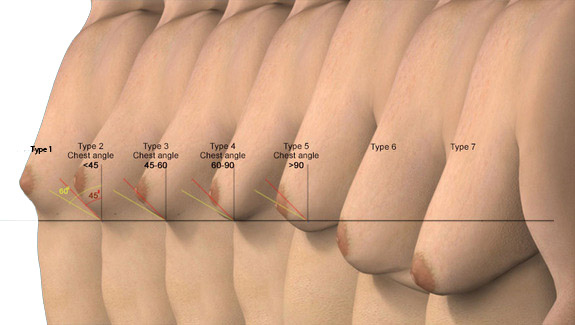
What are the treatment options for Gynecomastia?
There are few treatments for gynecomastia, but only surgery offers permanent and complete resolution of the condition. The options are:
Breast Reduction Pills:
There are some supplements that have been shown to give modest improvement of gynecomastia. They do not require surgery but come with significant disadvantages. They are not immediate and can be expensive over the long-run. They offer modest results and usually only in younger patients with mild conditions. And the modest reduction is in breast tissue only with no improvement in chest contour.
Chest Compression Shirts:
This is a temporary way of “hiding” gynecomastia. These shirts give compression to the chest and should be comfortable and non-restrictive. Although effective and immediate, this is not really a treatment in the strictest sense, and does nothing to resolve the underlying condition or symptoms. It also does nothing for the man that wants to look better without his shirt. Of note, most patients will be required to wear one of these shirts after surgery to help with swelling.
Surgical Treatments:
Surgical management is the most effective, immediate, and permenant treatment for gynecomastia. It can be customized to each person and offers correction of the contour of the entire chest. Recovery is usually quite quick. There are 3 surgical approaches for gynecomastia:
Liposuction:
- Liposuction is most effective for removing fatty breast tissue, but more dense/tough breast tissue may be removed with the addition of Vaser Ultrasound Assisted Liposuction or SAFELipo techniques. SAFELipo® contouring using PAL, or Power Assisted Liposuction, and Vaser Ultrasound Assisted lipouction work great in cases of mild to moderate gynecomastia with minimal excess skin. Drs. Gordon and Reid are the only certified SAFELipo® providers in all of Austin and have over 10 years experience with Vaser. Using both of these types of liposuction, there is less compromise of blood supply, nipple distortion and areola slough. In addition, postoperative complications are fewer with these technique than with open surgical resection; however, liposuction is usually not effective for correcting moderate to severe glandular gynecomastia. The fatty and glandular components of your breast must be assessed before surgery.
Excision:
- The dense/tough tissue below the nipple usually requires direct surgical excision and often cannot be removed with liposuction alone. Minimally invasive gynecomastia surgical procedures can sometimes be used. In the “pull-through technique,” a very small incision (approximately 5 mm) is made at the areolar edge. Following Vaser and/or SAFELipo®, the glandular tissue from the overlying areola is pulled through the incision. The major advantage of this procedure is a smaller incision.
- Direct excision may also be required in some cases, if there is excess skin to be removed or if the size of the areola must be adjusted. Most excision is performed through a small incision at the lower border of the areola only, but incision patterns must be adjusted based on the needs and goals of each patient.
Combined Liposuction & Excision:
- This is the most frequent treatment for gynecomastia, because it allows for the best treatment for all areas of the chest. Excision is reserved for the hard/dense tissue under the areola and liposuction is used for sculpting of the entire chest including the lateral chest (fatty tissue under the arms) and anterior axillary folds (fatty tissue in front of the armpit).
How long does it take to see the final result?
Gynecomastia surgical results are immediate and permanent, assuming your weight is stable. If your condition arose from the use of medication or anabolic steroids, further use could lead to recurrence.
Your Gynecomastia Concerns:
What if I don’t live in Austin?
Because Restora Austin is a center of excellence for chest contouring in the U.S. Dr Reid frequently treats patients from all around the world. We frequently do virtual consultation through email. The patient sends pictures and details that are reviewed by Dr. Reid and a plan is formed. Other times, FaceTime or Skype are used to perform a face to face virtual consultation. Once the plan is formed, surgery can be planned and booked. Usually, Dr. Reid will see the patient the day prior to surgery to formalize the plan. Inspire Surgery Centre offers overnight stay capability, and Restora has arrangements for differing levels of care for your stay, if you desire. Our goal is to provide you with an exceptional experience from beginning to end.
How long will my results last?
Gynecomastia surgical results are immediate and permanent, assuming your weight is stable. If your condition arose from the use of medication or anabolic steroids, further use could lead to recurrence.
How long does it take to see the final result?
- As with most surgeries, you may notice a decrease in sensation in the treated area(s). This is more frequent if you required significant liposuction. Most men find the temporary loss of sensation to be insignificant. Sensation returns after a year for most.
- In some patients with diminished elasticity (most commonly older patients), there may be excess skin or skin creases that are more noticeable postoperatively. Most of these creases will persist for six to twelve months and then diminish significantly, as the loose skin tightens with time and wound contraction.
- After male breast reduction surgery, there is a phenomenon of spontaneous shrinking of the entire areola. The diameter of the areola will decrease ten to fifty percent from the original size. This usually occurs after significant amounts of glandular tissue are removed.
- Be patient. It may be three months or more before the swelling abates and you can see the final results.
What will my scars be like?
Scars resulting from gynecomastia surgery vary, depending on the approach used and the elasticity of your skin. If your breasts are small and most of the excess tissue is fat, your scars will be tiny. If tissue needs to be removed from behind your areola, the incision will be placed under the areola. If the areolas are large and need reduction also, then the incision goes all the way around the areola. In rare cases of excessive tissue and skin, the scar may be placed in the lower chest crease. We will teach you how to take care of your incisions and scars to optimize their appearance long term. If your scars are not progressing they way we’d like them to, we have several options available, like Laser Scar Therapy.
What are the risks of gynecomastia surgery?
Like all surgical procedures, male breast reduction involves certain risks, including the possibility of bleeding, infection, fluid collection, changes in skin and nipple sensation, contour irregularities and/or unfavorable scarring. Drains are not typically used for gynecomastia surgery.
When can I get back to the gym?
We like for you to avoid vigorous exercise for several weeks after surgery to minimize bleeding and swelling. After 2 weeks if you are healing well, you can start some light cardio and get back in the pool. At 4 weeks, you will be able to get back to your regular exercise program.
How long will I need to take off of work?
Most men treated with a combination of Vaser and/or SAFELipo® and breast gland tissue excision take a week off from work.
What can I expect after surgery?
Your recovery time after gynecomastia surgery depends on how severe your condition is and what procedure you had. Gynecomastia surgery usually has a relatively gentle recovery period. You will probably be asked to wear a compression garment for a few weeks while you heal. There will be some swelling and bruising, but any post-operative pain can be managed with pain medication.
Where will my gynecomastia surgery be performed?
Your chest reduction will be performed as an outpatient procedure at INSPIRE, our fully accredited, AAAASF, surgery center. A board-certified anesthesiologist will administer general anesthesia.
What’s the difference between Restora Austin gynecomastia procedures and others?
What differentiates Dr. Reid most from other practices that perform gynecomastia surgery is his experience and aesthetic philosophy and his state-of-the-art equipment and techniques, like SAFELipo® and Vaser Liposuction. Dr. Reid has used both technologies for many years. Dr. Reid and Dr. Gordon trained with the creator and inventor of SAFELipo®, Dr. Simeon Wall, Jr. and are the only certified SAFELipo® providers in Austin. Dr. Reid will evaluate your anatomy and desires, and create a surgical plan that is tailored specifically for you.
Am I a good candidate for gynecomastia surgery?
Most men with gynecomastia are candidates for breast reduction surgery, but the best candidates are near their ideal weight and have no significant health problems. If you are overweight, we might advise you to try to lose weight first. Sometimes, weight loss can alleviate a male breast condition without surgery if the excess tissue is fat and not glandular tissue. If not, substantial weight loss after surgery could cause further sagging of your skin, and a revisionary surgery could be necessary.
Are you ready for your flat, masculine chest? Call Restora Austin today at 512.371.8817.


